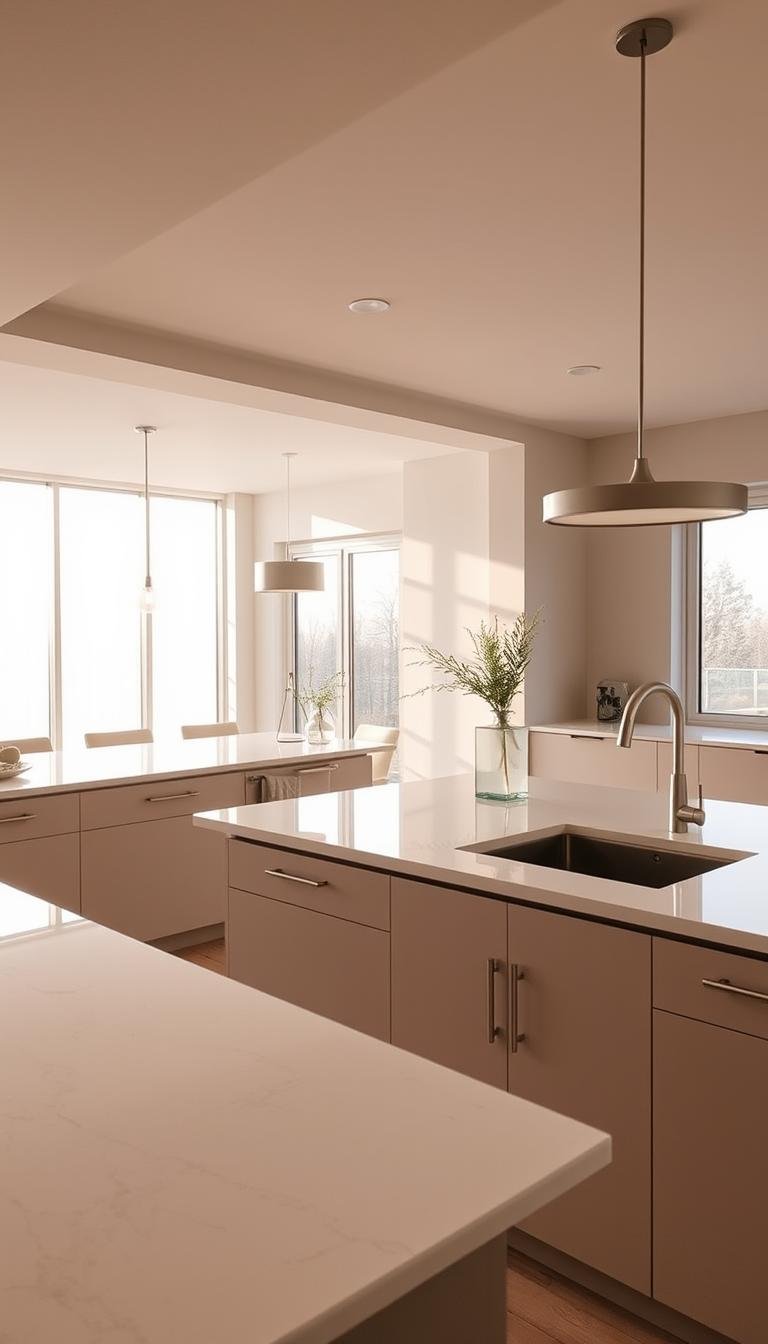This post may contain affiliate links. If you click and buy, we may earn a small commission at no extra cost to you. Learn more.
Every kitchen has a story to tell. For many, that story should last forever. A timeless kitchen is not about following trends. It’s about creating a welcoming space for today and tomorrow.
Picture a kitchen that grows with your family. Classic materials like marble countertops or oak cabinetry stay stylish over the years. These designs mix usefulness with elegance, making your kitchen a cherished part of your home for decades.
This guide will show you how to make a kitchen that’s both functional and stylish. Learn about smart layouts, durable materials, and color choices that keep your kitchen feeling fresh. Let’s dive into the essentials of a timeless kitchen.
Contents
- 1 What Makes a Kitchen Timeless?
- 2 Choosing Classic Materials for Longevity
- 3 Color Schemes That Stand the Test of Time
- 4 Timeless Kitchen Layouts
- 5 Incorporating Vintage Elements
- 6 Timeless Appliances and Technology
- 7 Lighting That Enhances Timeless Designs
- 8 Space Utilization Strategies
- 9 The Importance of Customization
- 10 Maintaining a Timeless Kitchen
- 11 Budgeting for Your Timeless Kitchen
- 12 Inspiration from Timeless Kitchen Designs
What Makes a Kitchen Timeless?
Timeless kitchens stay away from quick trends. They focus on lasting values. A classic kitchen design is all about balance, function, and details that feel both familiar and new. It’s a space that grows with you, never feeling old.
“Timelessness is about creating spaces that speak to human needs, not just current tastes.” – Jane Carter, interior design columnist
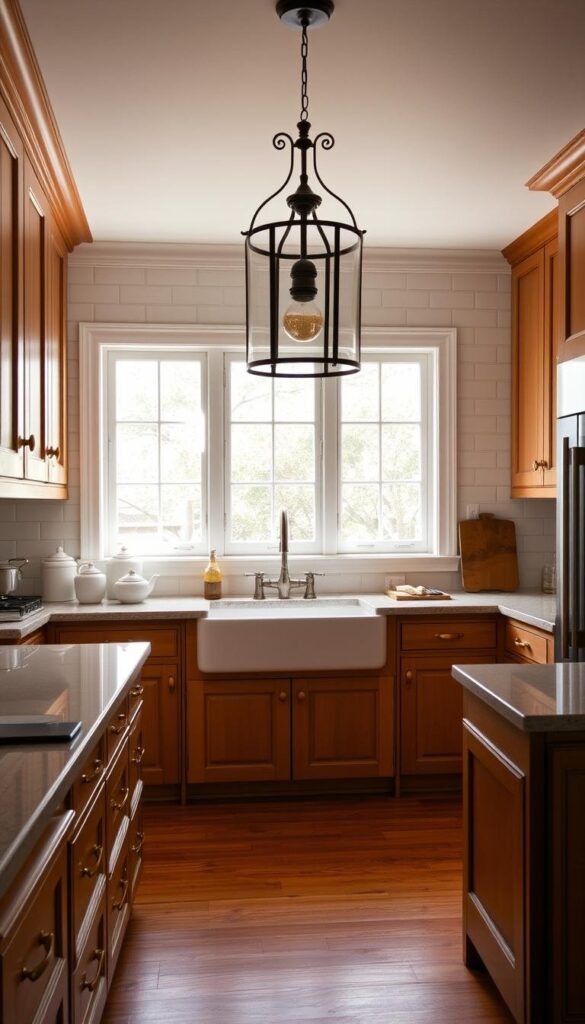
Understanding Timeless Design
Classic kitchen design is all about being both useful and beautiful. It follows a few key rules:
- Functionality: Layouts that make daily tasks easier
- Proportions that are balanced
- Materials that last through daily use
Key Elements of a Timeless Kitchen
These features help a kitchen last:
- Quality materials: Solid wood, durable hardware
- Neutral foundations: Subway tiles, light cabinetry
- Time-tested details: Soft-close drawers, recessed panel doors
Even small choices count. A well-chosen backsplash or perfectly sized shelves make a classic kitchen feel thoughtful and easy. This way, the space adapts to your life, not the other way around.
Choosing Classic Materials for Longevity
Materials are key in any traditional kitchen renovation. Choosing durable, classic options keeps your kitchen looking good for years. Whether it’s new cabinets, countertops, or floors, timeless materials are both beautiful and practical.
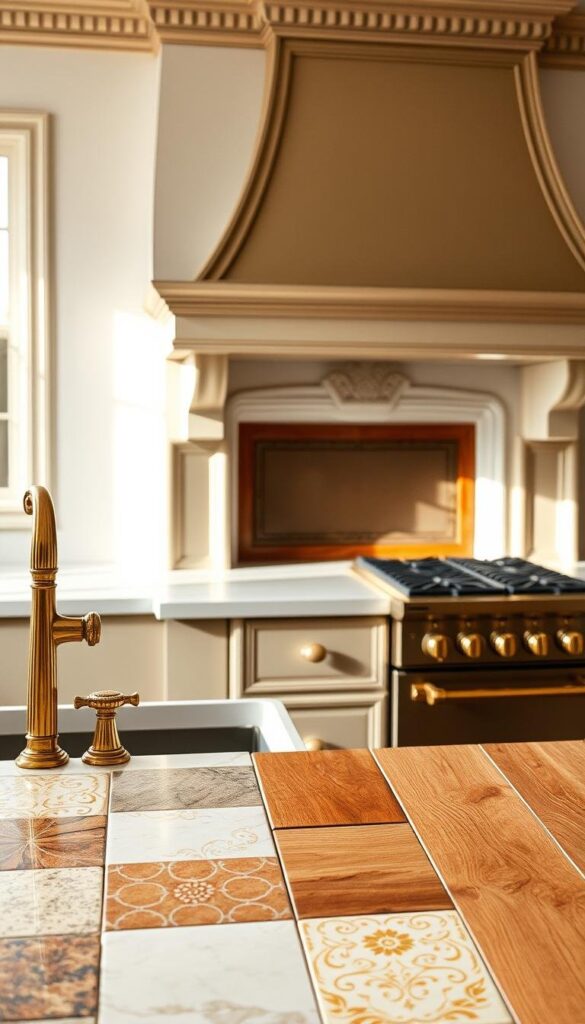
The Role of Natural Stone
Natural stone like marble, granite, and soapstone is incredibly durable. Marble adds elegance to formal kitchens, while granite is great for resisting stains and heat. Soapstone has a soft, earthy look that fits well with rustic designs.
These materials get better with age, gaining character without losing their quality.
Wood vs. Composite Options
- Wood: Solid hardwoods like oak or cherry bring warmth and timeless beauty. They can last a long time if properly sealed, but may get scratches.
- Composite: Engineered materials mix wood fibers with resins, making them moisture-resistant and less likely to warp. Brands like Wilsonart offer wood-like looks at a lower cost.
Wood gives a natural feel, while composites are better for areas that get wet, like backsplashes.
Durable Countertops: A Wise Investment
Countertops are essential for a kitchen’s function. Quartz surfaces from Caesarstone or Silestone have marble looks but are non-porous. Solid surface materials like Corian can fix chips and scratches, perfect for busy kitchens.
Even though they cost more upfront, these options last much longer than trendy ones.
Color Schemes That Stand the Test of Time
Color choices are at the heart of sophisticated kitchen decor. They mix personality with lasting appeal. Neutrals keep designs timeless, while smart accents prevent trends from taking over.

Neutral Palettes for Versatility
Whites, taupes, and soft grays form a neutral base. This base adapts to changing tastes. For example, a taupe backsplash works with both farmhouse and modern styles.
Earthy tones like olive greens or terracotta add warmth. They do so without losing flexibility.
- White cabinets stay crisp with occasional touch-ups.
- Beige countertops resist fading better than bright hues.
Adding Accent Colors
Inject personality through movable elements:
- Textiles: Patterned towels or linen curtains
- Appliances: A bold red espresso maker or chrome toaster
- Decor: Ceramic vases or geometric wall art
“A kitchen’s soul lives in its accents,” says interior designer Clara Bennett. “Let them evolve as your style grows.”
Balance Between Bold and Subtle
Limit bold choices to one accent wall or backsplash. A navy blue island contrasts neutrals without overwhelming the space. Pairing detailed patterns like floral tiles with solid-colored cabinets keeps things from getting cluttered.
Trying out colors is safe when you start with neutrals. Let your preferences guide your choices. Remember, less is often more in sophisticated kitchen decor.
Timeless Kitchen Layouts
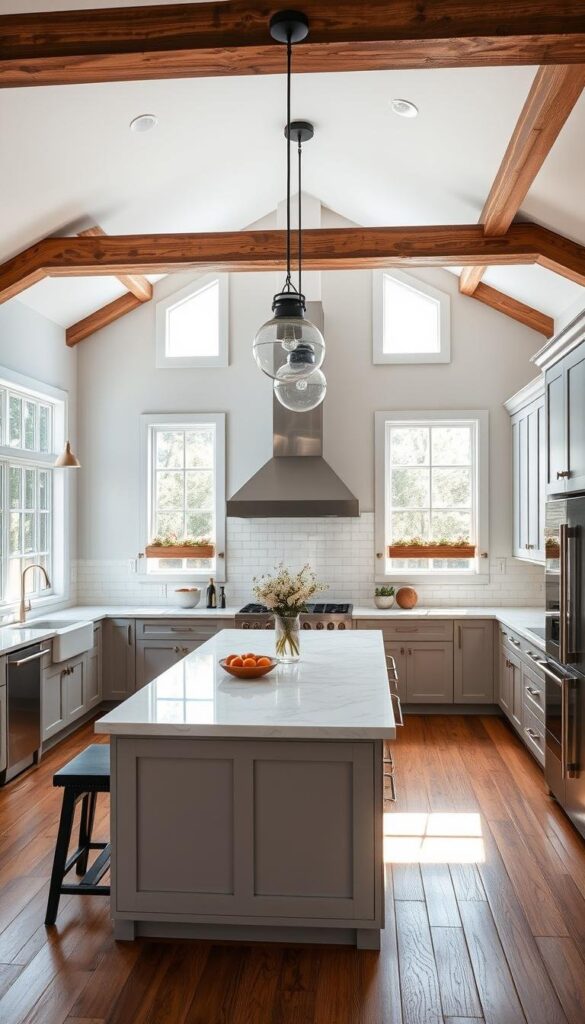
A timeless kitchen balances function and flexibility. It works whether it’s modern or classic. The key is smooth movement and easy use. Here’s how to make your kitchen last.
Open-Concept vs. Traditional Layouts
Open layouts mix kitchens with living areas, creating social spots. Traditional layouts have clear zones for cooking and dining. Choose what fits your life best. For example, IKEA’s modular designs offer flexibility by combining open and classic elements.
Efficient Work Triangles
Work triangles connect the sink, stove, and fridge. The right spacing saves steps without feeling cramped.
“A well-balanced triangle reduces effort and boosts efficiency,”
say designers. Modern kitchens often add islands or pantry areas to the mix.
The Importance of Flow
Good traffic flow is key. Focus on these points:
- Keep 36-42” clearance for main paths
- Place appliances near prep areas
- Make room for seating without blocking paths
Flexible layouts grow with your family, keeping your kitchen useful for years.
Incorporating Vintage Elements
Vintage kitchen inspiration brings history into modern spaces without losing function. Look for unique pieces that tell stories. Think cast-iron sinks from 19th-century foundries or hand-blown glass pendants. These add depth without overwhelming modern designs.
“A 1940s-era ceramic tile backsplash can anchor a minimalist kitchen,” says interior designer Clara Bennett. “It’s about balancing eras thoughtfully.”
Antique Fixtures and Hardware
Brass handles from mid-century brands like Knock or salvaged farmhouse faucets from Rejuvenation add character. Look for lever handles and oil-rubbed bronze finishes to blend old and new seamlessly.
Repurposing Old Materials
- Reclaimed barn wood shelving from Urban Lumber Co. creates organic texture
- Salvaged subway tiles from Tile Bar give backsplashes nostalgic charm
- Upcycled copper pots as pendant lights add industrial warmth
Achieving a Rustic Look
True rustic aesthetics rely on authentic patina. Avoid overdone distressing—opt for naturally aged oak countertops or weathered copper accents instead. Brands like BoConcept offer pre-loved finishes that mimic genuine aging.
Combine these elements strategically. A vintage chandelier above a quartz countertop or a salvaged mantel as an island base creates harmony. Let heirloom pieces like your grandmother’s copper kettle sit proudly on open shelves—they’re the heart of timeless design.
Timeless Appliances and Technology
Modern farmhouse kitchens are where function meets style. Choosing appliances that are both high-performing and stylish keeps your kitchen looking good for years. Opt for brands like KitchenAid or Sub-Zero, known for their classic looks that don’t go out of style.
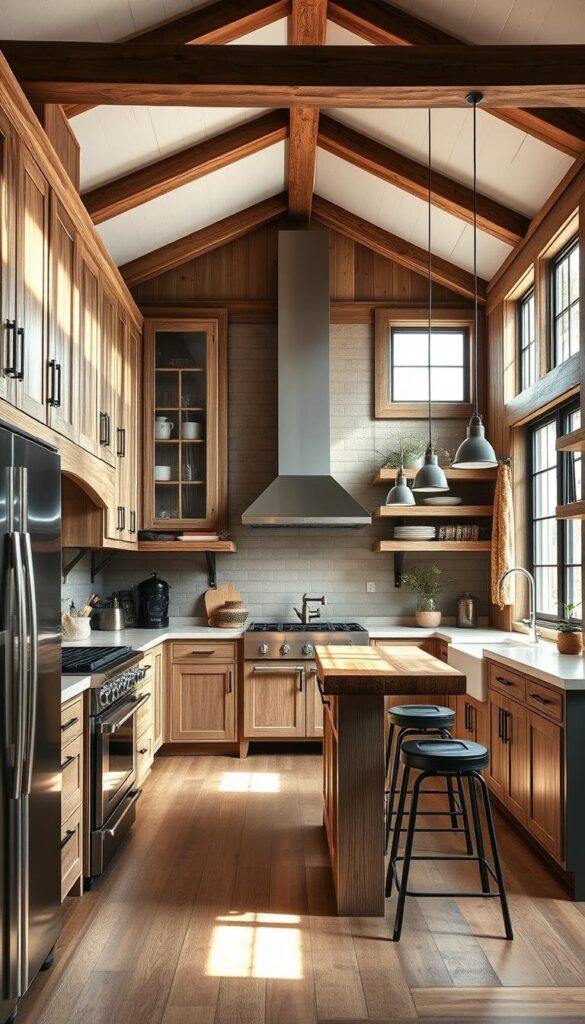
“The best appliances in a modern farmhouse kitchen are those you barely notice—until they work.” – James Carter, Kitchen Designer
Choosing Reliable Brands
Top brands offer both new tech and classic looks. Bosch and Thermador have models that fit right into your cabinets. Make sure to check for warranties and energy ratings to make sure your investment lasts.
Seamless Integration
- Use panel-ready refrigerators to hide brand logos
- Mount microwaves above counters for an understated profile
- Choose stainless steel or matte finishes to avoid dated looks
Energy Efficiency Considerations
Choosing Energy Star-certified appliances saves money in the long run. Induction cooktops from brands like Electrolux use 20% less energy. They’re a smart choice for a kitchen that’s both stylish and sustainable.
Lighting That Enhances Timeless Designs
Good lighting makes an elegant kitchen inviting. It brightens the space and sets the mood. Use layers of light for a design that lasts.
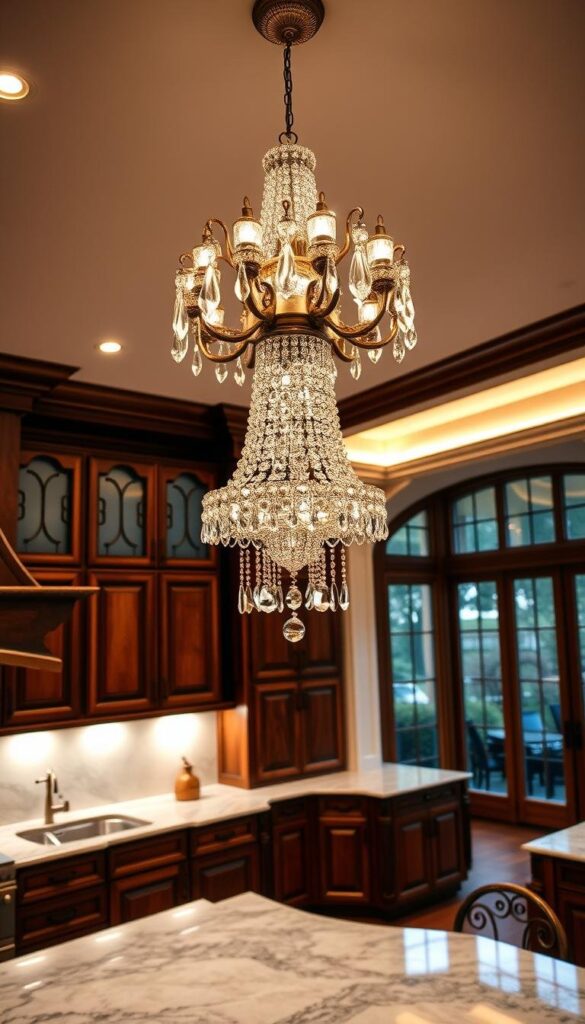
Layered Lighting Approaches
Balance three layers for the best look:
- Ambient: Recessed or cove lighting for a soft glow.
- Task: Under-cabinet strips or adjustable sconces for prep zones.
- Accent: Highlight backsplashes or art with directional fixtures.
Chandeliers and Pendant Options
Fixtures like Schoolhouse Electric’s pendants or Tech Lighting’s suspensions add charm. Pick sizes that match your kitchen. Small kitchens do well with clusters, while big spaces shine with bold chandeliers.
Task Lighting Essentials
Task areas need bright light without glare. LED strips or adjustable lamps provide the right amount. Dimmers are key for adjusting light levels. Remember, clean fixtures to keep them bright.
Space Utilization Strategies
Maximizing space without losing style is essential for timeless kitchens. Whether your kitchen is small or large, smart planning keeps it functional for years. Let’s look at strategies that mix practicality with lasting beauty.
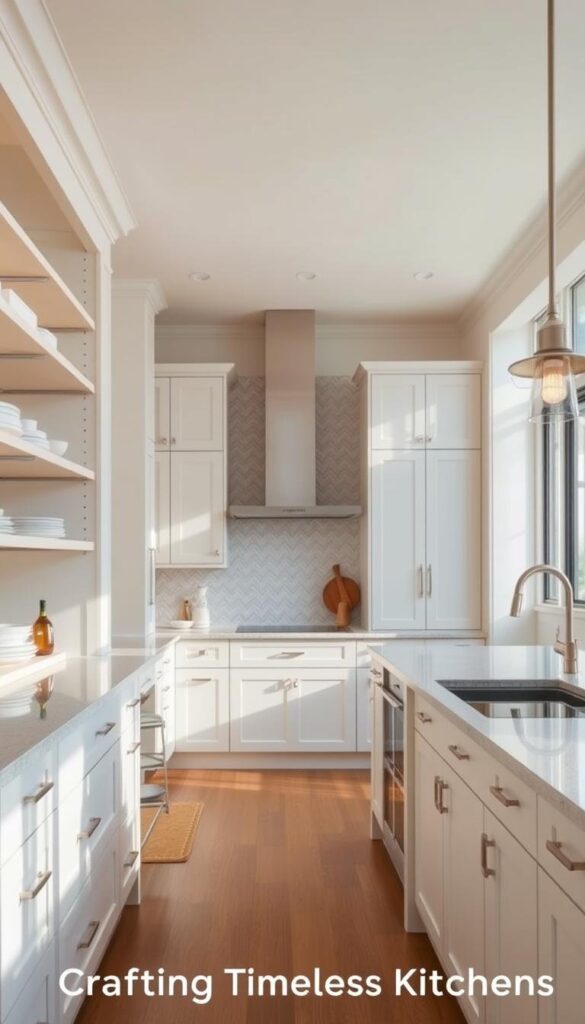
Creative Storage Solutions
Hidden pull-out towers, corner drawers, and vertical pantry systems make every inch useful. For instance, Blum or Knape & Vogt hardware turns awkward corners into useful spots. A Rollerblade pantry cart brings mobility to tight spaces. These ideas help keep your space tidy and fit your needs.
Functional Islands and Peninsulas
Islands aren’t just for big kitchens. A 36-inch-wide peninsula in small spaces can be a breakfast bar. Choose durable materials like quartz—Silestone or Zodiac brands are great. Add seating for casual meals or a prep sink for more efficiency.
Open Shelving Benefits
Open shelves work well when chosen carefully. Show off your favorite dishware from Le Creuset or use stackable baskets for snacks. Remember, only display items you love. As designer Martha Stewart says, “Keep things tidy by editing often.”
“The best timeless kitchen ideas focus on how you live—storage shouldn’t be an afterthought.”
- Use deep base cabinets for bulky items
- Install swing doors on tall units for easy access
- Pair open shelves with rolling carts for flexibility
Smart planning makes your kitchen adaptable to your family’s needs, avoiding trends. Begin by mapping your daily routines. This ensures every detail meets today’s needs and tomorrow’s changes.
The Importance of Customization
Classic kitchen design is all about you. It’s not just about following trends. It’s about how you live, cook, and entertain. Making your kitchen personal turns it into a space that grows with you.
Tailoring Design to Your Lifestyle
Begin by thinking about your daily habits. Do you love hosting big parties or cozy dinners? Do you enjoy baking or quick meals? These questions help decide what your kitchen needs.
- Focus on areas you use a lot, like a coffee station.
- Use hidden storage for things you only need seasonally.
- Choose seating that fits your social style, from stools to dining areas.
Unique Features to Consider
Think about adding special touches that show who you are:
- Cookbook displays that also decorate your kitchen.
- Special prep areas for your favorite activities, like baking or grilling.
- Hidden tech, like charging stations or smart storage.
Working with Professionals
Work with designers who really listen. Architects can make your kitchen more efficient. Craftsmen can add custom touches like unique cabinets. Their skills make sure your classic kitchen design is both personal and timeless.
A kitchen that changes with you becomes a beloved space for years. Let every detail tell your story while staying true to classic values.
Maintaining a Timeless Kitchen
To keep a timeless kitchen looking great for years, smart upkeep is key. Regular care helps materials age well and keeps their charm. Here’s how to keep things practical yet preserve the design.
Cleaning and Care Tips
For natural stone countertops, use cleaners like Bona or Method to avoid damage. Wooden cabinets need monthly dusting with a microfiber cloth. Stainless steel is best cleaned with a soft cloth and water.
Regular upkeep stops small problems from becoming big, expensive fixes.
Seasonal Decor Adjustments
- Swap out neutral textiles like linen placemats for holiday hues.
- Display fresh flowers in ceramic vases instead of plastic.
- Update wall art with seasonal themes while keeping frames classic.
These small changes keep the space feeling new without changing the core design.
Renovation vs. Restoration
When updating, ask: Does this keep the kitchen’s style intact? Renovation might add new appliances like a Bosch dishwasher. Restoration fixes old hardware with the right knobs. Choose upgrades that improve function without losing timeless charm.
Budgeting for Your Timeless Kitchen
Planning a traditional kitchen renovation means balancing today’s costs with tomorrow’s benefits. Making smart choices now keeps your kitchen both functional and beautiful for years. Let’s look at how to spend wisely without breaking the bank.
“A well-planned budget turns a kitchen into an asset, not just an expense.”
Start with cost-effective strategies to stretch your budget:
- Phase renovations over time instead of doing everything at once
- Shop seasonal sales for appliances or cabinetry
- Reuse existing hardware or lighting fixtures
- Cabinetry with solid wood cores (avoid particleboard)
- Low-maintenance countertops like quartz or Caesarstone
- Energy-star certified appliances from brands like Bosch or Sub-Zero
Long-term value considerations focus on durability over trends. While mid-range sinks might save upfront, high-quality stainless steel resists corrosion better. Ask: Will this choice save money in repairs or replacements over 10+ years? Upfront investment in quality materials often reduces future headaches.
Every traditional kitchen renovation budget has limits. Focus on core elements first—those that define functionality and durability. Small splurges here create bigger savings later.
Inspiration from Timeless Kitchen Designs
Timeless kitchens blend history, trends, and personal stories. They show that lasting design is not just about rules. It’s about mixing proven elements with your unique touch.
Iconic Timeless Kitchens
A modern farmhouse kitchen often combines whitewashed beams with simple sinks. These designs take inspiration from rural traditions but use modern materials. Mid-century layouts, with tapered legs or Shaker-style cabinets, also inspire. They show how classic designs evolve over time.
Trends That Endure
Vintage kitchen inspiration comes from details like subway tiles or oil-rubbed bronze hardware. Restoration Hardware mixes retro shapes with modern finishes. This proves timeless pieces can stay stylish. Adding subtle touches, like matte black faucets or reclaimed wood, brings character without following trends.
Personal Touches That Fit Your Style
Sophisticated kitchen decor becomes warm with personal touches. A handpainted backsplash or a collection of ceramic bowls adds charm. Mixing neutral tones with special textiles, like a grandmother’s quilt, makes a space both classic and personal.
To bring you cozy inspiration more efficiently, we sometimes use AI to assist in content creation — but every word and idea is carefully shaped by our team. See our AI Disclosure for more info.



